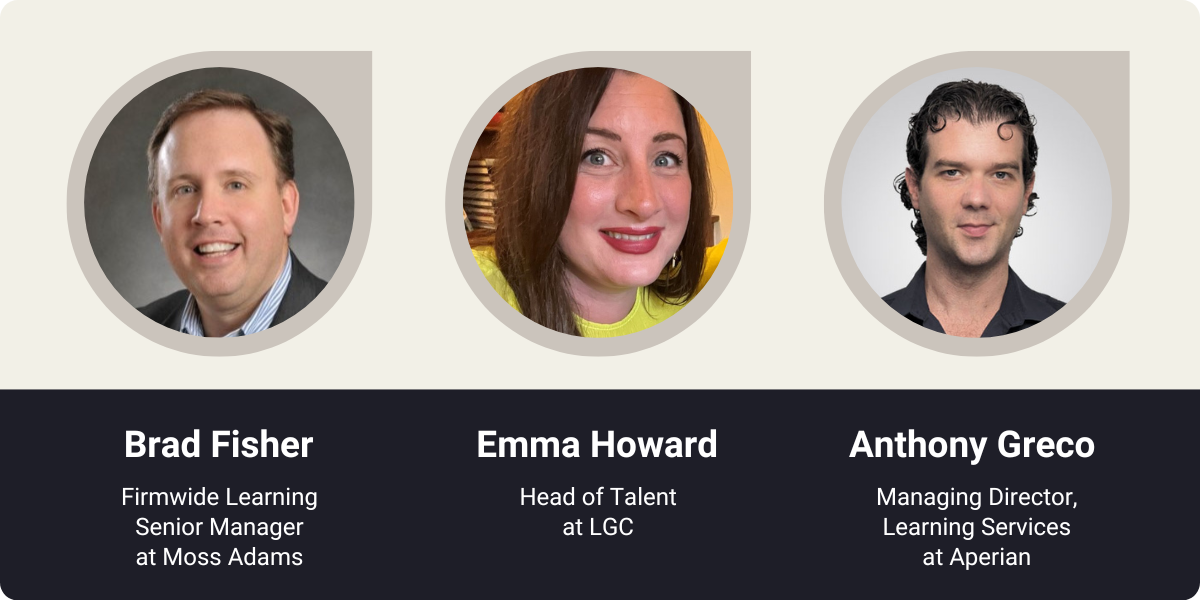


Like any other function or industry, the L&D field is ripe with trends—micro-learning, gamification, curated pathways, and so much more. Some of these trends turn into best practices, and some fizzle out over time. However, and unfortunately, one of the most recurring trends in L&D is: “How can I do more with less?” Budgets are cut, staff are reduced, and it can feel like you need to be an expert at everything.

Anthony Greco, Managing Director of Learning Solutions at Aperian, recently sat down with Brad Fisher, Firmwide Learning Senior Manager at Moss Adams, and Emma Howard, Group Head of Talent and Development at LGC, to discuss how L&D leaders can optimize their efforts with fewer resources. You can watch the recording and read through some of their helpful insights below.
Brad suggests starting with alignment with leadership and key stakeholders. “Get a sense for where the organization is wanting to go in the next 3-5 years, and that will give you a basis to ask what skills, knowledge, and abilities people need in order to fulfill that vision. Then you can start moving to an assessment of where we are today, where we need to go, and what our programs need to look like to get us there.”
Emma says, “Diagnostic is always the key for me—thinking about return on investment. We’re at an interesting period of L&D at the moment, where we no longer view it as just focused on the employee or just focused on the business—this is mutual upskilling.” Emma starts L&D plans by analyzing what she’s seeing and hearing throughout the organization, and thinking about what might benefit both the business and individuals.
Brad says: “In a resource-constrained environment, it’s critical that you have some sort of criteria for how you prioritize the work. One of the elements that I look for is alignment on what we’re doing—the needs for both today and where we’re going in the future. If you start to look at you know your list of asks—because we have these asks coming in all the time as L&D teams—how do we filter through the noise? Having a set of criteria can drive sanity in the work.”
Emma adds that it’s helpful to look at the systems and processes you already have to determine if they can serve additional functions. “Interestingly, that’s why I work with Aperian,” she says. “It enables me not just to generate team cohesion but also self-reflection, so it’s a two-for-one.”
Emma suggests starting by looking at the size, capability, and capacity of your learning team. Maybe you need to outsource something that your team could do quite easily, but just doesn’t have the capacity at the moment. “Often, things fall into a learning and development bucket that aren’t learning and development,” Emma says. “Performance management engagement is not learning and development, it’s part of the overall employee experience. I decide to in-source or outsource by being very clear about whether things fit within our learning and development remit or not.”
Brad adds: “It’s also about asking yourself, ‘What is the secret sauce of my organization?’ What are those things that your internal team knows best? There are a lot of trainings that are commoditized and you can find them very easily. So it comes down to what value your L&D team could bring above and beyond what you can find in the marketplace. That helps you cut down the noise and focus on what’s important.”
Brad’s teams have started leveraging ChatGPT and other AI tools alongside their own internal documents and processes to do an initial design treatment for courses. Then they start working with our subject matter experts on an editing effort versus a creation effort. “This works well for some of the more foundational knowledge that you need, and it’s a tremendous time saver,” Brad says.
While AI offers huge potential to organizations, Emma also emphasizes, “we’ve seen a drive back to more, and I hate this phrase, but “people-centric learning” after the pandemic. It’s fantastic we’ve got Zoom, and Teams, and AI, but I still believe that push for face-to-face learning is going to be one that actually gets greater. We’ve had a lot more calls for, ‘can we be in a room and actually experience the same thing together and share that knowledge?’ My advice is to choose whatever is going to maximize the learning.”
Emma suggests going back to objectives. “In L&D we tend to be big-picture thinkers. We like academic intellectual stimulation, but that doesn’t always fit with what the business actually needs. In the initial scoping conversation I agree on what the indicators of success will be, and I normally only go for two: scalability and participant feedback.”
Brad also says his team has found success by looking at the top performers at the company and determining the behaviors that are helping them achieve those results. That can help you focus on the specific skills and behaviors to instill throughout the organization and the learning people need to get there.
Emma says there are three elements at play:
Brad also suggests building a network of people in the organization who are passionate about developing others. You can engage them to help create content, facilitate learning, and be your eyes and ears throughout the business. “There are people out there who love to share what they know,” Brad says. “Then you’re not just one person, you’re really an enabler of multiple points of learning.”
He also suggests utilizing different tools to help scale your efforts. “I recommend utilizing tools like Aperian. When you look at how cost effective it is and the wealth of materials you have access to, it’s really pretty stunning and can really help you leverage quite a bit.”
—
Start a free trial of Aperian to see how our learning platform and training solutions can help you do more with less at your organization.